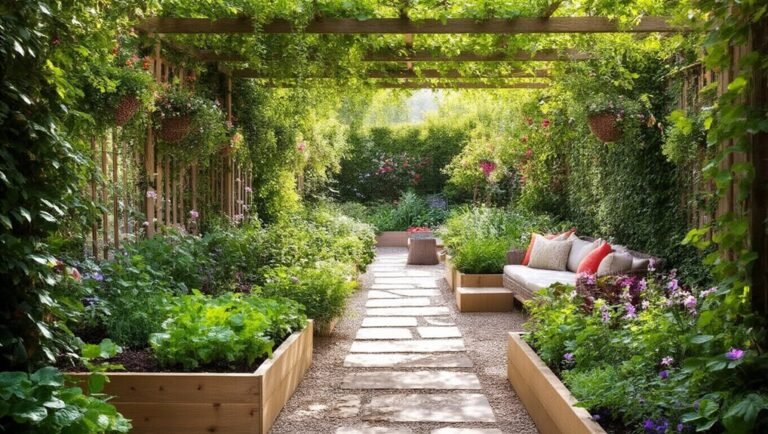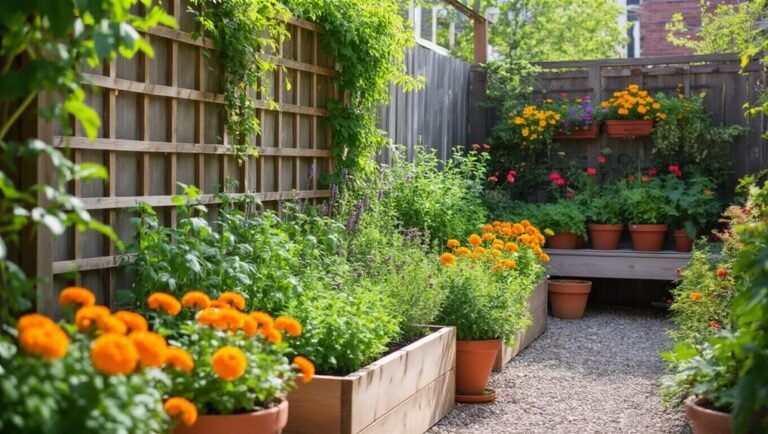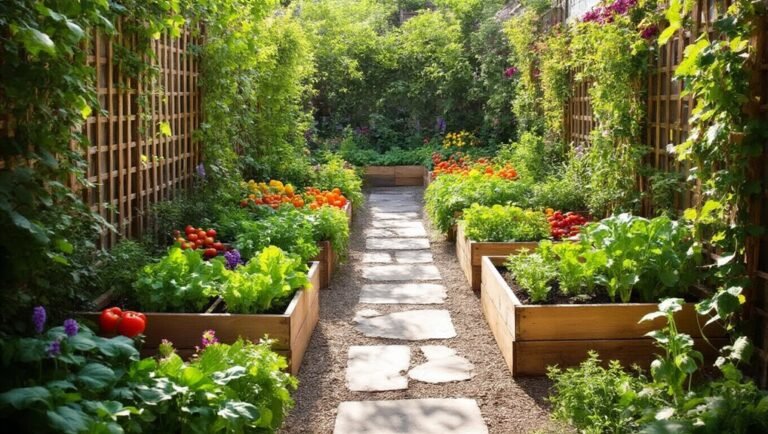For the perfect onion layout in your raised bed garden, choose versatile yellow onions or colorful red onions based on your needs. Plant seedlings 4 to 6 inches apart, or space bulbs 6 to 8 inches apart in rows, maintaining 12 to 18 inches between rows for easy access. Pair onions with carrots or basil for better growth, and ensure your soil is rich in nutrients. Stick around, and you’ll discover more tips for a thriving onion garden!
Key Takeaways
- Space onion seedlings 4 to 6 inches apart in rows, ensuring ample room for growth and air circulation.
- For onion sets or bulbs, maintain a spacing of 6 to 8 inches for optimal development.
- Keep row spacing at 12 to 18 inches to facilitate easy maintenance and harvesting.
- Incorporate organic matter like compost into loose, well-draining soil for nutrient-rich conditions.
- Use companion planting, such as carrots and lettuce, to enhance growth and deter pests.
Understanding Onion Varieties for Your Garden
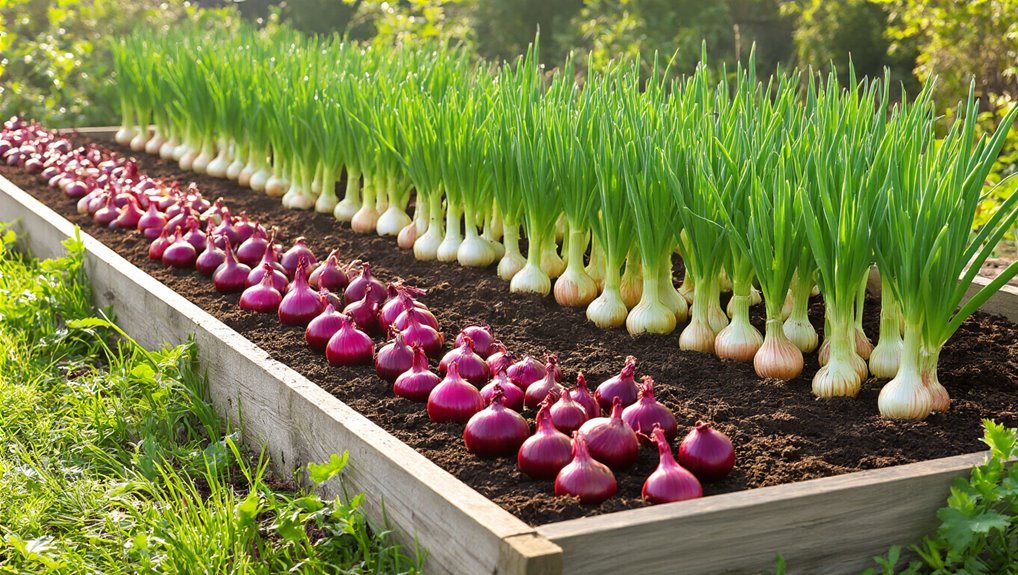
When you’re planning your raised bed garden, understanding the different onion varieties can make all the difference in your harvest. You’ll find three main types: yellow, red, and white onions.
Yellow onions are versatile and great for cooking, while red onions add a colorful crunch to salads. White onions have a sharper flavor, perfect for salsas and garnishes. Using mulch in your garden around your onions can help retain moisture, suppress weeds, and improve overall plant health.
Consider the growing season, too. Short-day onions thrive in southern regions, while long-day onions are better suited for northern climates.
Intermediate onions can grow well in both areas. For the healthiest onions, be sure to plant them in quality garden soil to ensure they thrive throughout the season.
Ideal Spacing for Healthy Onion Growth
After selecting the right onion varieties for your garden, it’s time to think about how to space them for optimal growth. Proper spacing allows for better air circulation, sunlight exposure, and nutrient uptake, leading to healthier onions. For gardeners looking to streamline their composting process, using a compost tumbler can efficiently create nutrient-rich material to boost onion bed fertility.
Here are three spacing guidelines to follow:
- Seedlings: Plant onion seedlings about 4 to 6 inches apart in rows. This distance encourages robust growth without crowding.
- Sets and Bulbs: If you’re using onion sets or bulbs, aim for 6 to 8 inches apart. This gives them room to expand and develop.
- Row Spacing: Maintain row spacing of 12 to 18 inches. This distance makes it easier to tend to your onions while providing adequate space for their growth.
To further enrich your garden soil and support onion health, consider using compost bins to create nutrient-rich compost for your raised beds.
Companion Planting: What to Grow With Onions
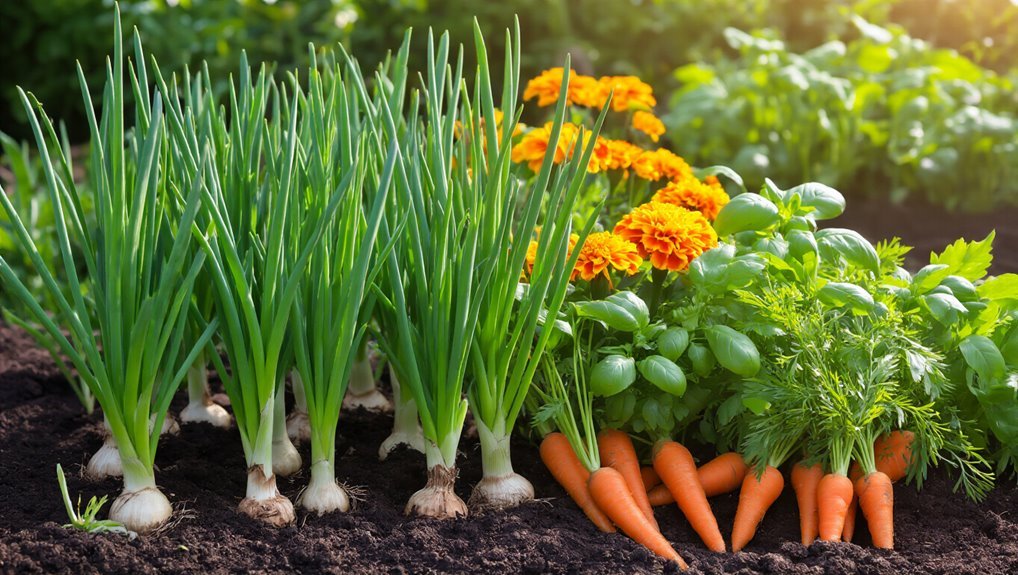
Companion planting can significantly enhance your onion garden by maximizing space and boosting growth. To benefit your onions, consider planting them alongside carrots, beets, and lettuce. These crops thrive in similar conditions and won’t compete for nutrients.
Carrots, in particular, can help deter pests like onion flies, creating a protective barrier around your onions. If you’re interested in introducing more variety and resilience to your garden, try incorporating Seed Bomb Kits for Guerrilla Gardening to quickly establish companion plants and attract beneficial insects.
Additionally, you can grow herbs like basil and sage nearby. These herbs not only repel certain insects but also improve the overall flavor of your onions.
However, avoid planting onions with peas or beans, as they may hinder each other’s growth.
If you’re interested in starting companion planting, you might find Herb Garden Kits with Seeds and Pots a convenient way to add beneficial herbs to your raised bed.
Soil Preparation and Nutrient Requirements
To ensure your onions thrive, proper soil preparation and nutrient management are key. Start with a loose, well-draining soil mix to promote healthy root development.
You’ll want to focus on these three essential components:
- Organic Matter: Incorporate compost or well-rotted manure to enrich your soil, providing vital nutrients and improving texture.
- pH Level: Aim for a soil pH between 6.0 and 6.8. You can test it easily with a home kit and adjust using lime or sulfur if necessary. For more accurate results, consider using a compost thermometer to monitor the conditions of your compost before adding it to the soil.
- Fertilization: Use a balanced fertilizer, high in phosphorus, to support bulb development. Apply it during planting and again when your onions begin to grow.
With these steps, your onions will have the nutrients they need for robust growth! For an even richer soil, consider adding outdoor composting systems to your garden routine, as they efficiently recycle organic waste into valuable plant food.
Irrigation Techniques for Raised Bed Onions
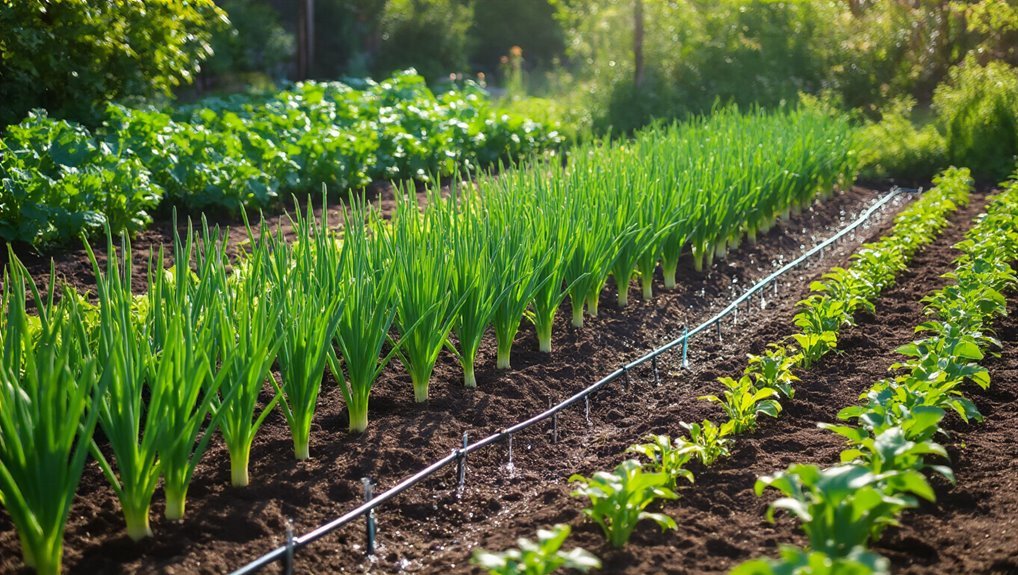
Effective irrigation is crucial for growing healthy onions in raised beds, as it helps maintain consistent moisture levels. You can use several techniques to ensure your onions receive adequate water.
Drip irrigation is an efficient method, delivering water directly to the roots while minimizing evaporation. If you prefer a more hands-on approach, consider soaker hoses, which can be laid out along the rows to provide deep watering.
Regularly check the moisture level in the soil; onions thrive with about an inch of water per week. During dry spells, adjust your watering schedule to prevent stress on the plants.
Pest Management and Disease Prevention
While growing onions in raised beds can be rewarding, managing pests and preventing diseases is essential for a successful harvest. Here are three effective strategies to keep your onions healthy:
- Crop Rotation: Change the location of your onion beds each season to disrupt pest and disease cycles. This practice reduces the chances of soil-borne diseases.
- Companion Planting: Plant onions alongside carrots, beets, or herbs like basil. These companions can deter pests and promote healthier growth.
- Regular Monitoring: Check your onions frequently for signs of pests or diseases. Early detection allows you to take immediate action, like using organic pesticides or removing affected plants.
Harvesting and Storing Your Onions
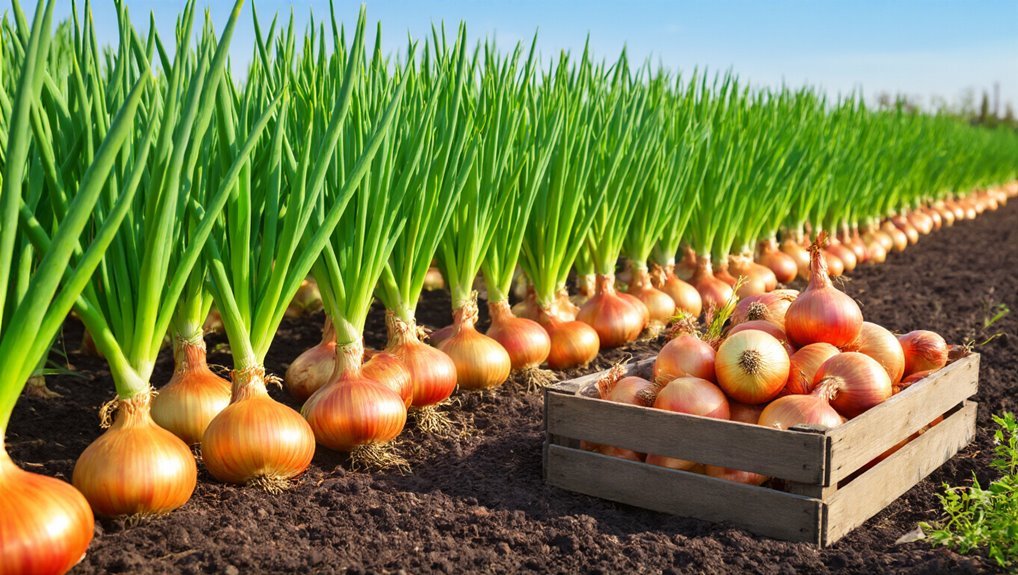
After ensuring your onions are healthy and free from pests and diseases, it’s time to focus on harvesting and storing them properly.
Wait until the tops start to yellow and fall over, signaling they’re ready. Gently lift the onions with a fork, avoiding damage. Brush off excess soil and let them dry in a warm, airy spot for a few days.
Once they’re fully dried, trim the roots and cut the tops to about an inch above the bulb. For storage, place them in a cool, dark, and well-ventilated area. You can use mesh bags or crates to prevent moisture buildup.
Check regularly for signs of rot and use any affected onions promptly to keep the rest healthy.
Frequently Asked Questions
Can I Grow Onions From Kitchen Scraps?
Yes, you can grow onions from kitchen scraps! Just save the root ends, place them in water or soil, and watch them regrow. It’s a fun and sustainable way to enjoy fresh onions at home!
What Is the Best Time to Plant Onions?
You should plant onions in early spring or late fall, depending on your climate. If you’re in a warmer area, fall planting works best; otherwise, wait for spring’s last frost to ensure healthy growth.
How Long Does It Take for Onions to Mature?
Onions typically take about 90 to 120 days to mature, depending on the variety. You’ll want to keep an eye on their growth and harvest them when the tops start to fall over.
Can Onions Be Grown in Containers?
Yes, you can grow onions in containers! Just choose a pot with good drainage, use quality soil, and ensure your onions get plenty of sunlight. They’ll thrive and provide a great harvest in limited space.
Are There Any Specific Diseases That Target Onions?
Onions, like a tender flower in the garden, face threats from diseases. You should watch for onion rot and downy mildew. Keeping your plants healthy helps shield them from these sneaky attackers lurking beneath the soil.
Conclusion
By following the perfect onion layout for your raised bed garden, you’re not just growing onions; you’re cultivating a rewarding experience. Did you know that homegrown onions can be up to 10 times fresher than store-bought ones? Imagine biting into a crisp, flavorful onion that you nurtured from seed to harvest. With proper care and attention, you’ll enjoy a bountiful yield that enhances your meals and brightens your kitchen. Now, let’s get planting!
